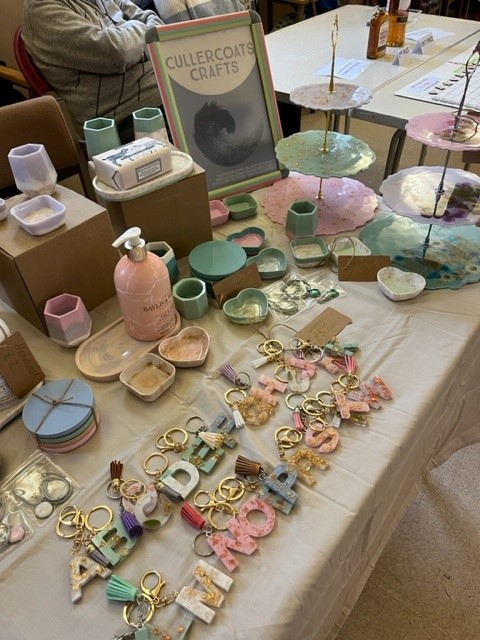How to start up a craft business
Looking to start up a craft business? Turning a hobby in to a business can be scary and daunting but really exciting too. Loads of crafters look to making money out of their hobby to supplement their income and it can be a great way to pay for your craft and push you to learn new skills.
There’s a few things I would recommend you look at before setting up your business:
Identify Your Niche:
Determine what type of crafts you’re passionate about and skilled in. It’s essential to have a clear focus, whether it’s knitting, jewellery making, woodworking, or any other craft. Is there a gap in the market? Can you make your items different by personalising something or offering a unique customisation?
Market Research:
Research your target market to understand what types of crafts are in demand, who your competitors are, and what price points are reasonable for your products. Visit local craft fayres, small businesses and check online on places like Facebook Marketplace, Etsy, Vinted and EBay.
Ask friends and family if there’s anything that they would like to see you make or for ideas on what they would be prepared to pay for your items. Just remember that what you might make and sell might not be appealing to everyone. Don’t be put off if you get poor responses or a lack of enthusiasm but do make sure you take on board everyone’s comments.
Business Plan:
Create a business plan outlining your goals, strategies, target audience, budget, and sales projections. A well-thought-out plan will guide your business decisions. Crafting can be expensive too so you’ll want to budget for any trial and error. Especially with crafts like resin, it can be costly if you make a mistake and need to start over. Factor this in to your costs and be realistic about wastage too.
Legal Requirements:
Register your business and decide on your business structure (sole proprietorship, LLC, etc.). Ensure you comply with local regulations and taxes. If you’re just starting out and earning under a certain threshold you might not need to register or be subject to taxes. Remember that not all images can be used on items that you sell. If you’re using well known images or logos, be sure to check out their trademarks. If you plan on selling electrical goods or things like candles and items for serving food, you’ll need to check your local area regulations. There may need to be testing that you have to prove you have done before you sell your items to the public.
Quality Matters:
Invest in quality materials and craftsmanship. High-quality products are more likely to succeed in the market and lead to repeat customers. You don’t want your items breaking and word getting out and damaging your business.
Make sure you test everything you make before you sell it. It will help you get good images for marketing too.
Friends and family are usually good market testers and I’m sure they would be really happy to receive free things from you that they can share on their social channels and with their friends too.
Pricing:
Calculate your costs (materials, labour, overhead, your time) and set competitive but profitable prices. Don’t undervalue your work; many customers are willing to pay for quality.
When you begin to sell to the public remember it’s not just a favour or gift! You will want to do some research in to your local market if you are selling locally online or at craft fayres. Visit as many craft shops and fayres before committing to your own. Take notes of other peoples prices and if they run any special offers etc.
Online Presence:
Create a professional website or use online marketplaces like Etsy or eBay to sell your crafts. Social media can also be a powerful tool for marketing and connecting with your audience. Creating a groups is a great way of creating a community of loyal customers or followers.
Check out our blog on ‘How to set up an Etsy Shop‘.
Scheduling posts can be a great way to reduce workload and ensure you’re not having to log on daily – although you’ll want to set expectations for your customers; let them know how quickly you’ll respond and what the best way is of getting in touch with you.

Branding:
Develop a brand identity, including a logo, business name, and a consistent style that reflects your craft’s essence. There’s lots of free online logo makers which you can use to create simple but effective logos and branding.
Remember that your name should represent you and your business. Keep things relevant to your products – it will help people quickly identify what you sell.
Photography:
Invest in good product photography. High-quality, well-lit images are essential for attracting customers online. Canva is a great free tool to design logos and flyers online for free.
Inventory Management:
Keep track of your inventory, and have a system for restocking and managing supplies. Avoid overstocking items that don’t sell well. Think about creating your items to order (unless attending craft fairs or stocking in shops).
Shipping and Packaging:
Decide on shipping methods, and make sure your products are well-packaged to prevent damage during transit. We love to re-use packaging to remain as eco-friendly as possible. Amazon and Temu have lots of cardboard packaging suggestions. Letting your customers know that you like to recycle packaging is a great way of being seen to be eco friendly and also lower costs. Just make sure you set the expectations before you send their items.
Customer Service:
Offer excellent customer service. Respond to inquiries promptly, and resolve any issues or complaints professionally. Be polite and respond positively even to constructive criticism.
Marketing and Promotion:
Use a wide range of marketing strategies to promote your craft business. Social media marketing, email marketing, and attending craft fairs and markets all help create brand awareness. Ask local businesses if they are happy to have your flyer in a window.
Friends and family are a great way of helping you share your business and posts for free. Just be prepared for some people to be not as keen. That’s ok! Not everyone will like your products. Don’t be offended if they are not as enthusiastic as you are.
Networking:
Build relationships within the crafting community. Attend craft fairs and join craft-specific forums or groups to learn from others and promote your business.
Feedback:
Listen to customer feedback and be open to making improvements in your products and services. Remember, what you like may be different to your customers!
Financial Management:
Keep track of your finances, including income, expenses, and taxes. Consider using accounting software or hiring a professional if needed.
Time Management:
Running a craft business can be time-consuming. Balance your crafting, marketing, and administrative tasks effectively.
Consistency:
Consistency in quality, branding, and customer service is key to building trust and a loyal customer base.
Patience and Perseverance:
Success in a craft business often takes time. Be patient and keep working on improving your craft and your business skills. Don’t give up!
Top Tip
Remember that building a successful craft business is a gradual process. Be adaptable, learn from your experiences, and don’t be discouraged by initial challenges. Over time, your craft business can grow and thrive.




